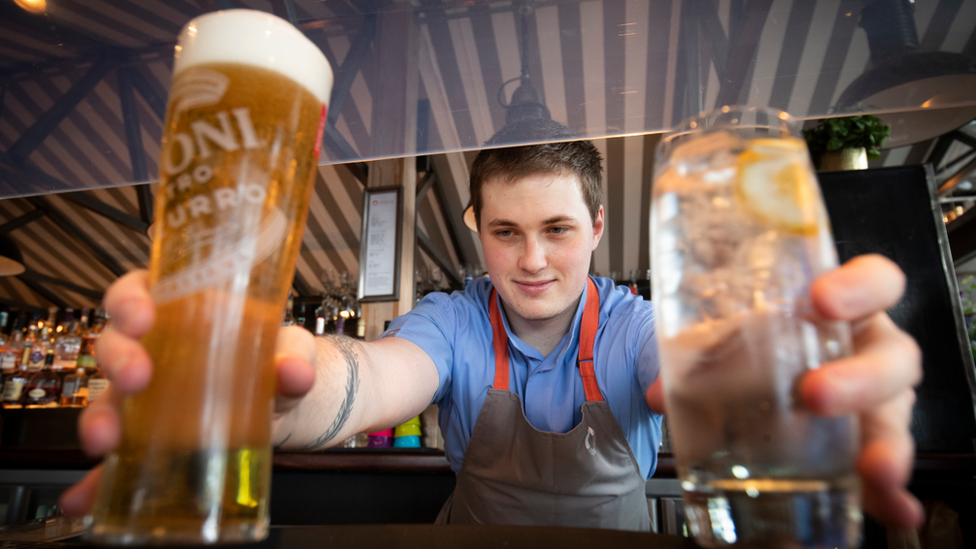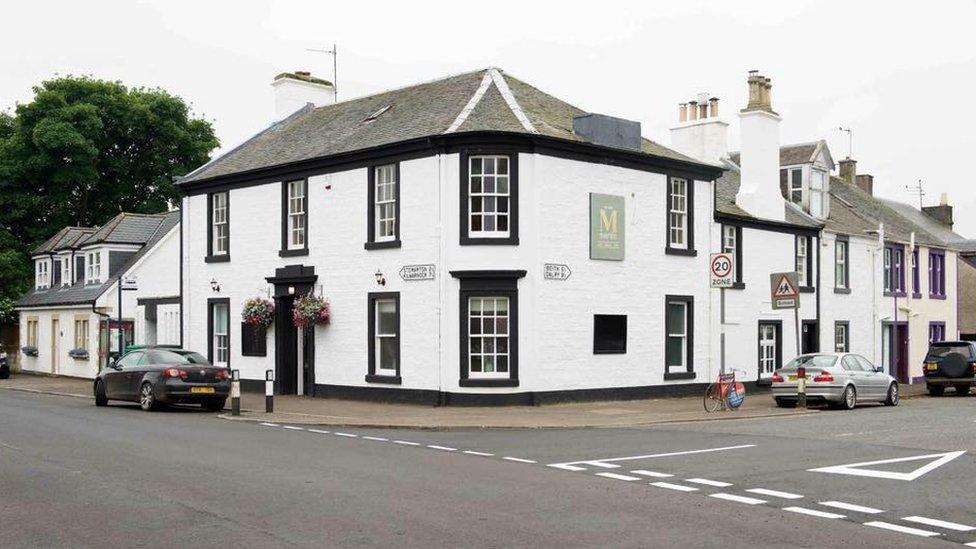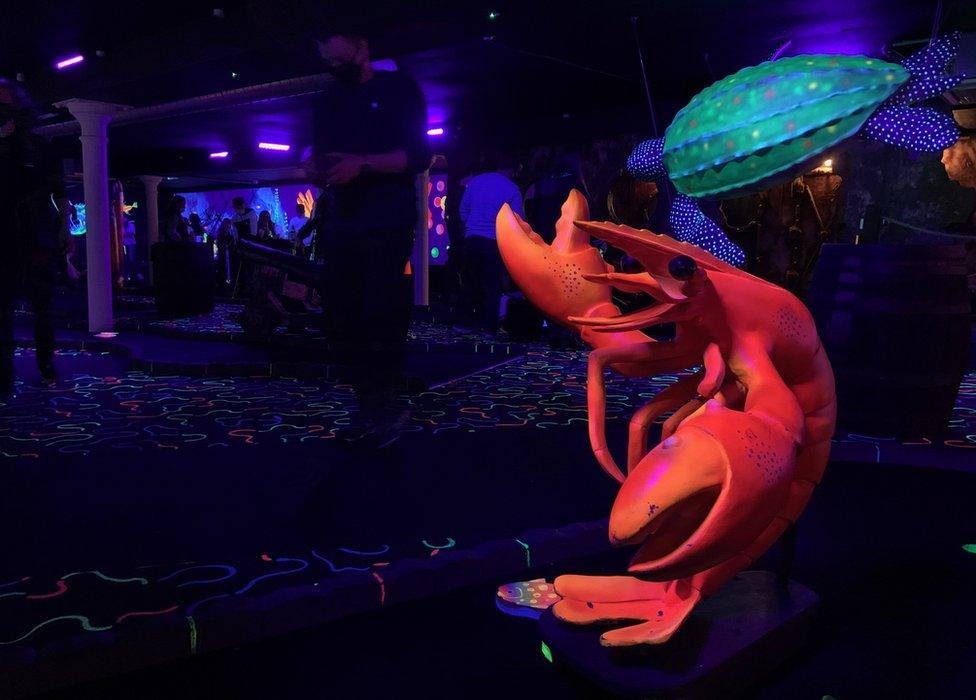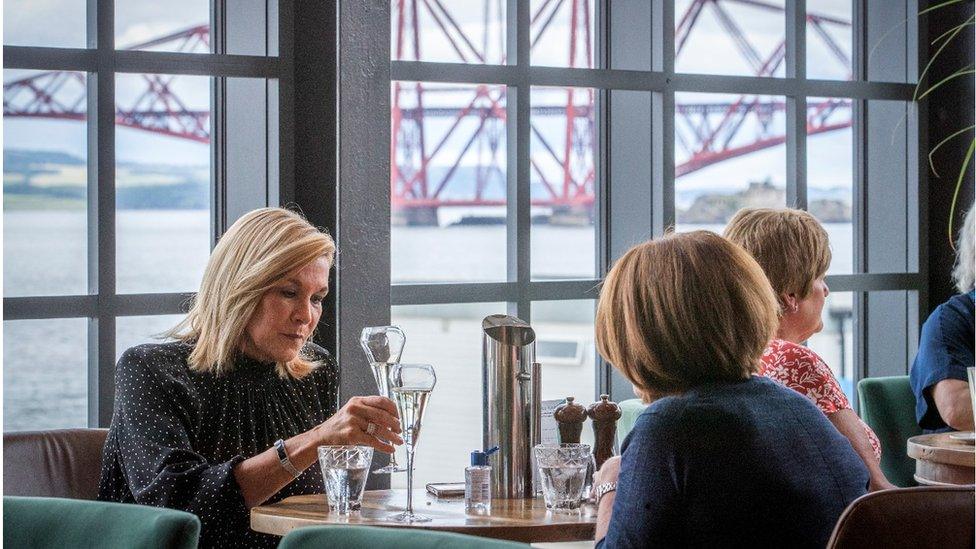Last orders for 'at least a third of pubs'
- Published

Pubs reopened this summer but their problems are not behind them
The pub is having a torrid Covid-19 crisis, as infection controls have accelerated long-running declining trends of alcohol consumption.
Young people are avoiding drink and pubs, so the on-trade is having to look to "experiences" to draw them back.
Restaurants are under threat too, from overstretched chains and home delivery, while entire town and city centres face radical choices.
The pub is under threat as never before: at least a third of howfs and hostelries face permanent closure, according to experts on the sector.
The outlook from the point of view of the Scottish Licensed Trade Association (SLTA) is far worse than that.
Its spokesman, Paul Waterson, said its most recent survey of a tenth of the membership pointed to a third of them being financially non-viable.
But he told me, for a special report on Radio Scotland, that the introduction of 10pm closure, along with restrictions to only two households meeting in groups of no more than six, has greatly worsened the outlook.
The SLTA estimate is now for up to two-thirds of them having to close in the next few months. And whereas it previously estimated 12,500 job losses, that forecast has doubled.

The time honoured tradition of getting a round in is less ingrained in younger people
Such projections are what could happen if there is no government intervention to support the sector. And perhaps those numbers are inflated to get the attention of policy-makers.
But I heard also from Spiros Malandrakis, an expert in the on-trade worldwide for Euromonitor marketing consultants. His estimate is for a third to half of British pubs being forced to close, permanently, and in only three months.
Unlike live entertainment and conferences, the root of the problem is not Covid-19. As I found in researching for the radio report, the infection has rapidly accelerated several pre-existing trends that were bearing down on the traditional pub.
Supermarkets went aggressively into off-sales, with cut-price offers, and drinking at home now accounts for more than three-quarters of drink consumed.
The indoor smoking ban in 2006, and tighter drink-drive limits a decade later, were widely welcomed for health and for safety, but are blamed by the SLTA for causing immense damage to the trade.
Young people are staying away from pubs in droves, and a high proportion are choosing not to drink. They're not replacing an older generation who are, to put it bluntly, dying.
Why? Mr Malandrakis told me it's partly the fear that drunkenness can so easily be pictured and placed on social media, permanently and indelibly.
He also said that brewers see Tinder, the dating app, as the biggest threat to their business, as it makes it easy to find a date without getting off your sofa. And he forecasts that the widening, legal access to cannabis will "cannibalise" the alcohol market.
Brewers and distillers are adapting their marketing strategies to drink at home, and enterprising firms have offered cocktails-to-the-doorstep during the Covid-19 crisis.
But for the on-trade, the answers are more difficult to find. They were already responding with more food options. Restaurants, meanwhile, are competing for alcohol sales with bars.
Some have specialised in craft beers on tap that you can't get at home.
In some cases, pubs facing closure have been taken over by their local communities, to retain their role at the centre of village social life.

The local community in Dunlop, East Ayrhire, bought the village's last remaining pub
An answer with a growing feature in London aimed mainly at a young demographic is making the pub into more of an "experience".
You can find axe-throwing, electronic darts, ball pits for adults or pay to let rip pent-up anger by beating up old white goods with a baseball bat.
It has also brought back something that seemed to go out of fashion around 50 years ago: crazy golf.
The new take on the old theme features indoor spaces with extravagant artwork, funky UV lighting and, in normal times when it's allowed, pumping music.

A new Rumble in the Jungle outlet in Glasgow has an ocean theme
One such outlet is opening in Edinburgh, while Fife-based Angus Wright owns four Jungle Rumble outlets, one in Glasgow drawing on set designers for Game of Thrones to create his ocean-themed basement.
He sees an opportunity for more outlets in locations where retail space is getting much cheaper because commercial landlords are desperately trying to fill it, and to attract more footfall.
In shopping malls, those same landlords are also finding it a struggle to hold on to "casual dining" outlets. While their cocktail menus have undermined bar-going, they are also facing some very tough times due to Covid-19.
Home delivery, often through powerful online presences such as Deliveroo and Just Eat, is gobbling up the industry, and bringing many more "eating out" experiences to the home.

Both pubs and restaurants are facing challenges that have been compounded by the Covid crisis
Few restaurants can afford to ignore consumer trends towards takeaways, deliveries, a social media strategy. They find fast food - already very digital - is fast growing its share as well.
In August, it was estimated that UK job losses in such food service firms ran to 22,000, with big numbers going from Pizza Express, Frankie and Benny's, Bella Italia and Byron burgers.
And it's not just restaurants and pubs: high streets and town centres are facing powerful long-term trends in changing consumer behaviour and technology.
Leigh Sparks, retail professor at Stirling University, told me it has to do with too much built space in the wrong locations, the growth of online options and increased localisation forcing retailers to reverse their moves into out-of-town shopping centres and warehouses.
To Malcolm Fraser, the Edinburgh architect whose report on town centres was the starting point for a lot of current urban policy, there is a need to go further.
Government tends to do the easy things, he told me, but it has to go to the root of a lot of town centres' problems by fundamentally reforming the way commercial property and activity is taxed.
You can hear lots more by listening back to a 30 minute report starting at 1 hour 28 minutes, on Good Morning Scotland, from Sunday 4 October: